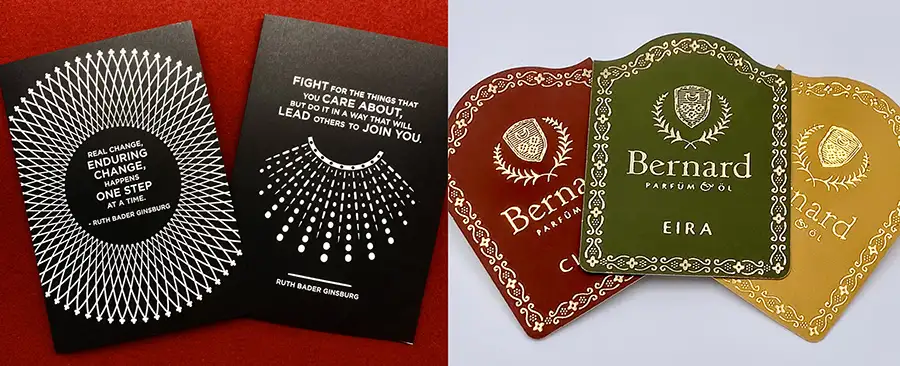
By David Drucker, CEO and founder, highresolution
I have been blessed working with a creative community in New York City. In my career, it didn’t take long before I realized my clients were not just sending me their commodity printing but also including me in their creative conversations. I developed my trade and began to view my work as a form of art. And it was then that the caliper of work changed, and I had to up my game and teach myself the art of graphics.
Since my first production in 1983, I have been using embellishments as part of my regular printed productions when appropriate. The first was a black A6 envelope that needed my client’s branding and return address. I was introduced to hot stamping, and I opted for a beautiful black-on-black foil stamping. The black foil ironed out the texture on the paper and appeared clean, smooth and added a wonderful contrast. I then began to invest and put my money where my mouth was, trying so many papers and techniques.
Forty years later, technologies have changed but the desire to offer embellished techniques has not. And now there are so many alternatives – some the same and some that are helping to change designs. Embellishments should work naturally with design but not appear forced. “We want every bell and whistle on this brochure,” says the client. That might sound like a great opportunity to spend the client’s money but, in my opinion, there is nothing artful about that type of production. Artful is what I go for. Quality over quantity.
Choosing the right time to add embellishments
I define an embellishment as a foil stamp (hot), cold foil, emboss, deboss, letterpress impression, engraving, clear screened UV, sleeking or the metallics and clear UVs from machines such as a JETvarnish or Scodix.
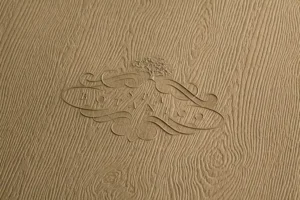 When a client asks me to quote a production, the first thing I ask for is an idea of the design. That tells me the story of who will be receiving the piece – whether for a luxury event, direct mail campaign or influencer packaging. The design already might be slotted for an embellishment. I will visit my client or send similar pieces I’ve produced, maybe using different foils or sculptured embossing as a way to start our conversation. By introducing my past experiences in print, it gives the client alternatives that could enhance the end-production. If my client knows exactly what is wanted this time, my samples can help influence future productions.
When a client asks me to quote a production, the first thing I ask for is an idea of the design. That tells me the story of who will be receiving the piece – whether for a luxury event, direct mail campaign or influencer packaging. The design already might be slotted for an embellishment. I will visit my client or send similar pieces I’ve produced, maybe using different foils or sculptured embossing as a way to start our conversation. By introducing my past experiences in print, it gives the client alternatives that could enhance the end-production. If my client knows exactly what is wanted this time, my samples can help influence future productions.
What we do not want is to just grab the files and go right into production. I have found that sometimes an interpretation actually has several meanings. So, we want to produce what best works for that particular production. That comes as a result of our conversations and recommendations.
Digital embellishments
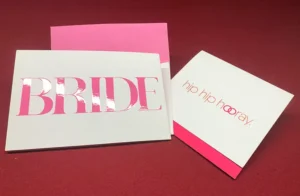 The digital world has changed the game for short-run productions. Digital embellishments are like jewelry to me. I find that only some of my clients really know about these enhancements. So, again, samples are important and can change the design in a whole new direction. I find that 80% of all my short-run work now is designed for press. Variable printing can be produced in gold foils and looks great. The price also is very competitive for short-runs with no dies or long makereadies – even when producing a one-off.
The digital world has changed the game for short-run productions. Digital embellishments are like jewelry to me. I find that only some of my clients really know about these enhancements. So, again, samples are important and can change the design in a whole new direction. I find that 80% of all my short-run work now is designed for press. Variable printing can be produced in gold foils and looks great. The price also is very competitive for short-runs with no dies or long makereadies – even when producing a one-off.
What digital embellishments also provide is a low-cost means of experimenting. Since there is no tooling, designs can be changed on the fly. So much knowledge can be gained through these types of experiments.
The art of embellishments
Important to me is working with a press person who sees the artistry in the profession. It is amazing the ideas that come with this type of relationship. Knowing the press person and press tolerances means there is less of a guessing game. And the more opportunities one has to have these discussions and experiment on press, the more perfection will be required.
I had been bouncing around and working with quite a few finishing companies in the early ‘80s. I was introduced to a company in my building called Gailer Stamping and Die Cutting in 1985. Specifically, I worked with a man named Michael Pinciotto. The difference when working with Michael? He took an interest in every production I worked on with him. We had discussions of techniques. His enthusiasm carried right to his press operators, who would push the boundaries. It was so great to learn and experiment with such a great production partner. Designers should ask themselves, “Who’s my Michael?”
It also is important to get educated on all the wonderful papers available. A slight change in texture, color and weight can influence embellishments into a new direction. Don’t be afraid to experiment by throwing a few extra sheets into the mix when in production. It is “school” for thought and leads to new ideas.
I like the refraction of light from the different angles of all embellishments. When a finished, well-produced production is handed to a client, watch the client’s face light up. Embellishments are the jewelry and candy of our industry. A great emboss or deboss works with light and reveals shadows, and foils reveal reflection. Find the height or depth of an embellishment and push it just before the point of the paper cracking. Play with clear UVs and see what can be done to make them better. The more designers experiment, the more ideas they’ll have and that makes an easy sale!
Conclusion
The bottom line is that I am a consultant who makes recommendations for every production. There is not any phase of the job that I am not fully involved with. That is my advantage, but it also takes up a great deal of time. When recommending embellishments, I can see the end result in my head. It is at this point that I begin to pull on my experiences and offer a direction I would like to see. There’s no reason why I can’t try to reach a higher level of artistry. My clients love this, and it has made my sales process easier and so much more exciting – especially with embellishments! I recommend designers pull on their experiences and state a redirection they would like to go.
David Drucker is the founder of highresolution, a print consultancy and production management firm. Serving bi-coastal clients, he partners with solopreneurs, design firms, creative agencies and C-suite creative directors at the strategic level to enhance printing, packaging and environmental graphics. Learn more at www.high-res.com.
Hot-Stamping, Embossing Produces Eye-Catching Holiday Card
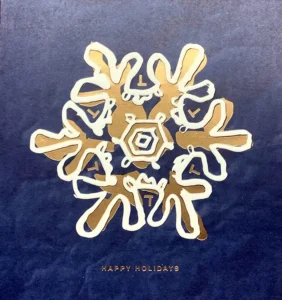 When awarded this holiday card from Lafayette 148, a global lifestyle brand based in the SoHo district in New York City, David Drucker, CEO and founder of highresolution, faced a few challenges in keeping all of the elements pronounced. There were several versions of the inside copy so, he said, it did not make sense to print conventionally. Drucker opted for the HP Indigo.
When awarded this holiday card from Lafayette 148, a global lifestyle brand based in the SoHo district in New York City, David Drucker, CEO and founder of highresolution, faced a few challenges in keeping all of the elements pronounced. There were several versions of the inside copy so, he said, it did not make sense to print conventionally. Drucker opted for the HP Indigo.
The pattern is taken from a sweater that Lafayette 148 had in its winter catalog. “When I saw the actual garment, there were copper highlights and thicker white highlights. Digital embellishments would not work because of their relief bump, so I took my digitally printed sheets and moved them to conventional hot stamping and embossing,” Drucker said.
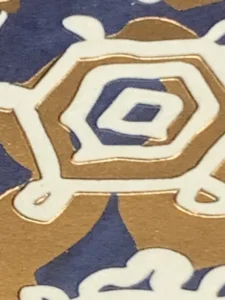 The copper is hot stamped with light pressure. Drucker said he usually would like to push the paper a bit, but the foil needed to be subtle. On the other hand, the blind emboss was created with a sculptured die to help enhance the feel of the white from the sweater.
The copper is hot stamped with light pressure. Drucker said he usually would like to push the paper a bit, but the foil needed to be subtle. On the other hand, the blind emboss was created with a sculptured die to help enhance the feel of the white from the sweater.
“The sculpture pushed the paper just enough so your eye will capture the shadows and refraction of light without having to run your hand over it,” Drucker said.
Overall, he said, all of the printing, stamping and embossing work well together and do not compete with each other.
“I am looking forward to next year’s Holiday Card challenges,” he added.

